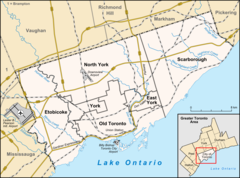Vale of Avoca
| Vale of Avoca | |
|---|---|

Vale of Avoca nears completion, November 3, 1924
|
|
| Coordinates | 43°41′21″N 79°23′20″W / 43.689160°N 79.388882°WCoordinates: 43°41′21″N 79°23′20″W / 43.689160°N 79.388882°W |
| Carries | 5 lanes of St. Clair Avenue (originally 4 lanes with 2 streetcar tracks) |
| Crosses | Avoca Ravine |
| Locale | Toronto, Canada |
| Other name(s) | St. Clair Viaduct |
| Maintained by | Toronto Transportation |
| Characteristics | |
| Design | Truss arch bridge |
| Total length | 155.1 m (509 ft) |
| Width | 19.7 m (65 ft) |
| Clearance above | 27 m (89 ft) |
| Clearance below | Yellow Creek |
| History | |
| Opened | 1924 |
| Statistics | |
| Daily traffic | St. Clair Avenue East |
| Toll | No |
The Vale of Avoca is the name of a deep ravine and of a large viaduct which carries St. Clair Avenue East over the ravine, in Toronto, Canada. The bridge is located just east of Yonge Street. The current triple arch bridge, also known as the St. Clair Viaduct, was built to connect the well-established community of Deer Park with the developing community of Moore Park. The bridge replaced an older structure and straightened the alignment of St. Clair Avenue in the process. The bridge and ravine are named after a poem by Thomas Moore. A small channelized tributary of the Don River, known as Yellow Creek, weaves beneath the central span. Much of David A. Balfour Park (named for aToronto city councilor) consists of a nature trail that winds through the Vale of Avoca Ravine; the park also includes a grassy recreational area near an inlet into which Yellow Creek flows.
The first bridge over the Vale of Avoca was an iron bridge, built in 1888. The bridge was built by John Thomas Moore in the hopes of encouraging investment in his new subdivision, Moore Park. Under the condition that he build the bridge, the Township of York purchased a strip of land across the valley and leased it to Moore, who was in return given the St. Clair Avenue right-of-way between Avoca Avenue and Inglewood Drive.
On December 16, 1912, Moore Park was annexed into Toronto at the instigation of landowners eager to obtain municipal services. Due to growing safety concerns regarding the old iron bridge, Toronto City Council authorized construction of a new bridge in 1922. Unlike the old bridge, this one would follow the straight alignment of St. Clair Avenue East (renamed in 1914). Two houses were expropriated and demolished, and the new structure built over two years at the cost of $716,653.58 ($8,914,622.90, adjusted for inflation) It opened to traffic in November or December, 1924.
...
Wikipedia

